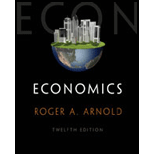
Concept explainers
Identify the
Explanation of Solution
The production of countries A and B is shown in the table below:
Table 1
| Country | Commodity X | Commodity Y | |
| A | 10 | 20 |
1X= 2Y 1Y= .5X |
| B | 30 | 40 |
1X= 1.33Y 1Y= .75X |
According to the table, Country A requires less labor hour for both X and Y. 1 unit of X is produced with the help of 10 labor hour. As given above, 30 labor hours are required in Country B. in the case of commodity Y Country A requires 20 hours and country B requires 40 hours. Country A requires less labor hours to produce Y than B. According to the theory of comparative advantage, Country A has advantage in both goods. But it makes trade on Commodity X because it has maximum advantage on Commodity X and Country B also makes trade on Commodity X because it has minimum disadvantage in commodity.
Comparative advantage: Country can go with trade with a good, which has the highest comparative advantage or lowest comparative disadvantage (lowest opportunity cost).
Opportunity cost: Opportunity cost is a loss of a good opportunity when the other one is chosen.
Want to see more full solutions like this?
- how commond economies relate to principle Of Economics ?arrow_forwardCritically analyse the five (5) characteristics of Ubuntu and provide examples of how they apply to the National Health Insurance (NHI) in South Africa.arrow_forwardCritically analyse the five (5) characteristics of Ubuntu and provide examples of how they apply to the National Health Insurance (NHI) in South Africa.arrow_forward
- Outline the nine (9) consumer rights as specified in the Consumer Rights Act in South Africa.arrow_forwardIn what ways could you show the attractiveness of Philippines in the form of videos/campaigns to foreign investors? Cite 10 examples.arrow_forwardExplain the following terms and provide an example for each term: • Corruption • Fraud • Briberyarrow_forward
- In what ways could you show the attractiveness of a country in the form of videos/campaigns?arrow_forwardWith the VBS scenario in mind, debate with your own words the view that stakeholders are the primary reason why business ethics must be implemented.arrow_forwardThe unethical decisions taken by the VBS management affected the lives of many of their clients who trusted their business and services You are appointed as an ethics officer at Tyme Bank. Advise the management regarding the role of legislation in South Africa in providing the legal framework for business operations.arrow_forward




 Economics (MindTap Course List)EconomicsISBN:9781337617383Author:Roger A. ArnoldPublisher:Cengage Learning
Economics (MindTap Course List)EconomicsISBN:9781337617383Author:Roger A. ArnoldPublisher:Cengage Learning





